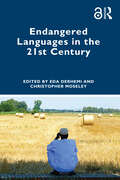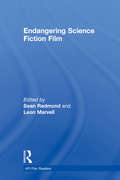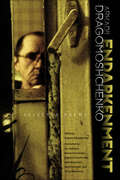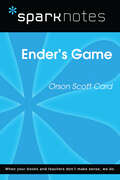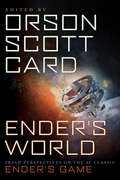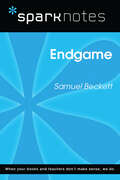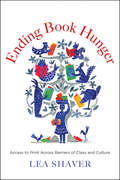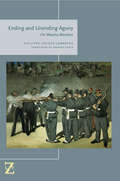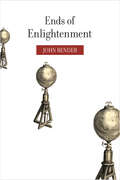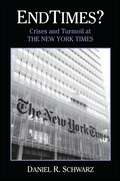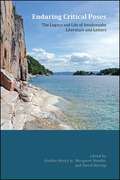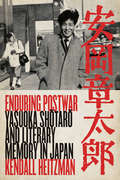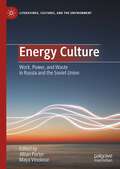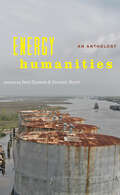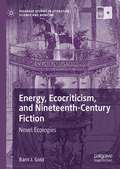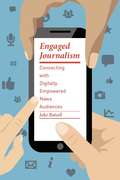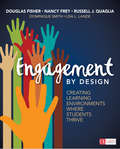- Table View
- List View
Endangered Languages in the 21st Century
by Christopher Moseley Eda DerhemiEndangered Languages in the 21st Century provides research on endangered languages in the contemporary world, the challenges still to be faced, the work still to be done, and the methods and practices that have come to characterize efforts to revive and maintain disadvantaged indigenous languages around the world. With contributions from scholars across the field, the book brings fresh data and insights to this imperative, but still relatively young, field of linguistics. While the studies acknowledge the threat of losing languages in an unprecedented way, they focus on cases that show resilience and explore paths to sustainable progress. The articles are also intended as a celebration of the 25 years’ work of the Foundation for Endangered Languages, and as a parting gift to FEL’s founder and quarter-century chair, Nick Ostler. This book will be informative for researchers, instructors, and specialists in the field of endangered languages. The book can also be useful for university graduate or undergraduate students, and language activists. The Open Access version of this book, available at www.taylorfrancis.com, has been made available under a Creative Commons Attribution-Non Commercial-No Derivatives 4.0 license.
Endangered Languages: Insights From Endangered Languages (The MIT Press Essential Knowledge series #12)
by Evangelia AdamouA concise, accessible introduction to language endangerment and why it is one of the most urgent challenges of our times.58% of the world’s languages—or, approximately 4,000 languages—are endangered. When we break this figure down, we realize that roughly ten percent of languages have fewer than ten language keepers. And, if one language stops being used every three months, this means that in the next 100 years, if we do nothing, 400 more languages will become dormant. In Endangered Languages, Evangelia Adamou, a specialist of endangered languages and a learner of her own community language, Nashta, offers a sobering look at language endangerment and what is truly lost when a language disappears from usage.Combining recent advances from the Western scientific tradition—from the fields of linguistics, psycholinguistics, neurolinguistics, language attrition, population genetics, and natural language processing—and insights from Indigenous epistemology, theory, and ethics, Adamou examines a wealth of issues surrounding endangered languages. She discusses where endangered languages are found, including how they are faring in a digital world, why these languages are no longer used, and how communities can reclaim languages and keep them strong. Adamou also explains the impact of language continuity on community and individual health and well-being, the importance of language transmission in cultural transmission, and why language rights are essentially human rights.Drawing on varied examples from the Wampanoag Nation to Wales, Endangered Languages offers a powerful reminder of the crucial role every language has in the vitality and well-being of individuals, communities, and our world.
Endangering Science Fiction Film (AFI Film Readers)
by Sean Redmond Leon MarvellEndangering Science Fiction Film explores the ways in which science fiction film is a dangerous and endangering genre. The collection argues that science fiction's cinematic power rests in its ability to imagine ‘Other’ worlds that challenge and disturb the lived conditions of the ‘real’ world, as it is presently known to us. From classic films such as 2001: A Space Odyssey and Solaris to modern blockbusters including World War Z and Gravity, and directors from David Cronenberg to Alfonso Cuarón, contributors comment on the way science fiction film engages with dangerous encounters, liminal experiences, sublime aesthetics, and untethers space and time to question the very nature of human existence. With the analysis of a diverse range of films from Europe, Asia, North and South America, Endangering Science Fiction Film offers a uniquely interdisciplinary view of the evolving and dangerous sentiments and sensibility of this genre.
Endarkenment: Selected Poems (Wesleyan Poetry Series)
by Arkadii DragomoshchenkoThe poet Arkadii Dragomoshchenko made his debut in underground magazines in the late Soviet period, and developed an elliptic, figural style with affinities to Moscow metarealism, although he lived in what was then Leningrad. Endarkenment brings together revisions of selected translations by Lyn Hejinian and Elena Balashova from his previous American titles, long out of print, with translations of new work carried out by Genya Turovskaya, Bela Shayevich, Jacob Edmond, and Eugene Ostashevsky. This chronological arrangement of Dragomoshchenko's writing represents the heights of his imaginative poetry and fragmentary lyricism from perestroika to the time of his death. His language—although "perpetually incomplete" and shifting in meaning—remains fresh and transformative, exhibiting its roots in Russian Modernism and its openness to the poet's Language School contemporaries in the United States. The collection is a crucial English introduction to Dragomoshchenko's work. It is also bilingual, with Russian texts that are otherwise hard to obtain. It also includes a foreword by Lyn Hejinian, an essay on how the poetry reads in Russian, a biography, and a list of publications. Check for the online reader's companion at endarkenment.site.wesleyan.edu.
Ender's Game (SparkNotes Literature Guide Series)
by SparkNotesEnder's Game (SparkNotes Literature Guide) by Orson Scott Card Making the reading experience fun! Created by Harvard students for students everywhere, SparkNotes is a new breed of study guide: smarter, better, faster.Geared to what today's students need to know, SparkNotes provides:chapter-by-chapter analysis explanations of key themes, motifs, and symbols a review quiz and essay topics Lively and accessible, these guides are perfect for late-night studying and writing papers.
Ender's World: Fresh Perspectives on the SF Classic Ender's Game
by Janis Ian Aaron JohnstonExperience the thrill of reading Ender's Game all over again Go deeper into the complexities of Orson Scott Card's classic novel with science fiction and fantasy writers, YA authors, military strategists, including: Ender prequel series coauthor Aaron Johnston on Ender and the evolution of the child hero Burn Notice creator Matt Nix on Ender's Game as a guide to life Hugo award–winning writer Mary Robinette Kowal on how Ender's Game gets away with breaking all the (literary) rules Retired US Air Force Colonel Tom Ruby on what the military could learn from Ender about leadership Bestselling YA author Neal Shusterman on the ambivalence toward survival that lies at the heart of Ender's story Plus pieces by: Hilari Bell John Brown Mette Ivie Harrison Janis Ian Alethea Kontis David Lubar and Alison S. Myers John F. Schmitt Ken Scholes Eric James Stone Also includes never-before-seen content from Orson Scott Card on the writing and evolution of the events in Ender's Game, from the design of Battle School to the mindset of the pilots who sacrificed themselves in humanity's fight against the formics
Endgame (SparkNotes Literature Guide Series)
by SparkNotesEndgame (SparkNotes Literature Guide) by Samuel Beckett Making the reading experience fun! Created by Harvard students for students everywhere, SparkNotes is a new breed of study guide: smarter, better, faster.Geared to what today's students need to know, SparkNotes provides:chapter-by-chapter analysis explanations of key themes, motifs, and symbols a review quiz and essay topics Lively and accessible, these guides are perfect for late-night studying and writing papers.
Ending Book Hunger: Access to Print Across Barriers of Class and Culture
by Lea ShaverAn eye-opening exploration of “book hunger”—the unmet need for books in underserved communities—and efforts to universalize access to print Worldwide, billions of people suffer from book hunger. For them, books are too few, too expensive, or do not even exist in their languages. Lea Shaver argues that this is an educational crisis: the most reliable predictor of children’s achievement is the size of their families’ book collections. <P><P>This book highlights innovative nonprofit solutions to expand access to print. First Book, for example, offers diverse books to teachers at bargain prices. Imagination Library mails picture books to support early literacy in book deserts. Worldreader promotes mobile reading in developing countries by turning phones into digital libraries. Pratham Books creates open access stories that anyone may freely copy, adapt, and translate. <P><P>Can such efforts expand to bring books to the next billion would-be readers? Shaver reveals the powerful roles of copyright law and licensing, and sounds the clarion call for readers to contribute their own talents to the fight against book hunger.
Ending and Unending Agony: On Maurice Blanchot (Lit Z)
by Philippe Lacoue-LabarthePublished posthumously, Ending and Unending Agony is Philippe Lacoue-Labarthe’s only book entirely devoted to the French writer and essayist Maurice Blanchot (1907–2003). The place of Blanchot in Lacoue-Labarthe’s thought was both discreet and profound, involving difficult, agonizing questions about the status of literature, with vast political and ethical stakes.Together with Plato, Holderlin, Nietzsche, Benjamin, and Heidegger, Blanchot represents a decisive crossroads for Lacoue-Labarthe’s central concerns. In this book, they converge on the question of literature, and in particular of literature as the question of myth—in this instance, the myth of the writer born of the autobiographical experience of death.However, the issues at stake in this encounter are not merely autobiographical; they entail a relentless struggle with processes of figuration and mythicization inherited from the age-old concept of mimesis that permeates Western literature and culture. As this volume demonstrates, the originality of Blanchot’s thought lies in its problematic but obstinate deconstruction of precisely such processes.In addition to offering unique, challenging readings of Blanchot’s writings, setting them among those of Montaigne, Rousseau, Freud, Winnicott, Artaud, Bataille, Lacan, Malraux, Leclaire, Derrida, and others, this book offers fresh insights into two crucial twentieth-century thinkers and a new perspective on contemporary debates in European thought, criticism, and aesthetics.
Ends of Enlightenment
by John BenderEnds of Enlightenment explores three realms of eighteenth-century European innovation that remain active in the twenty-first century: the realist novel, philosophical thought, and the physical sciences, especially human anatomy. The European Enlightenment was a state of being, a personal stance, and an orientation to the world. Ways of probing experience and knowledge in the novel and in the visual arts were interleaved with methods of experimentation in science and philosophy. This book's fresh perspective considers the novel as an art but also as a force in thinking. The critical distance afforded by a view back across the centuries allows Bender to redefine such novelists as Defoe, Fielding, Goldsmith, Godwin, and Laclos by placing them along philosophers and scientists like Newton, Locke, and Hume but also alongside engravings by Hogarth and by anatomist William Hunter. His book probes the kinship among realism, hypothesis, and scientific fact, defining in the process the rhetorical basis of public communication during the Enlightenment.
Ends of the Global City: Disaffection, Displacement and the New Cultural Ecologies of the Urban (New Comparisons in World Literature)
by Jini Kim Watson Rashmi VarmaThis volume of essays explores how the global city is confronting new forms of crises and disruption. Examining cities in the Caribbean, North America, Africa, the Persian Gulf, Asia and Australia, the essays use literary and cultural analysis to examine the pasts, present and futures of the global city. Ranging from the period of high postcolonial development, industrialization and compacted modernization to present-day neoliberal urban planning, the collection considers arrivals and departures in the global city, offering new critical vocabularies to analyse ongoing processes of migration, economic immiseration, and environmental collapse.
Endtimes?: Crises and Turmoil at the New York Times (Excelsior Editions)
by Daniel R. SchwarzFrom false stories about weapons of mass destruction in Iraq to growing competition from online and twenty-four-hour cable news, the first decade of the twenty-first century was not particularly kind to the New York Times. In this groundbreaking study of the recent life and times of America's most important newspaper, Daniel R. Schwarz describes the transformation of the Times as it has confronted not only its various scandals and embarrassments but also the rapid rise of the internet and blogosphere, the ensuing decline in circulation and print advertising, and the change in what contemporary readers want and how they want to get it.Drawing on more than forty one-on-one interviews with past and present editors (including every living executive editor), senior figures on the business and financial side, and publisher Arthur Sulzberger Jr., Schwarz discusses virtually every aspect of the contemporary Times, from columnists to cultural coverage. He explains how, in response to continuous online updating and twenty-four-hour all-news radio and television, the Times has become much more like a daily magazine than a traditional newspaper, with increased analysis (as opposed to reporting) of the news as well as value-added features on health, travel, investing, and food.After carefully tracing the rise of the Times's website, Schwarz asks whether the Times can survive as a print newspaper, whether it can find a business model to support its vast print and online newsgathering operation, and whether the Sulzberger family can survive as controlling owners. He also asks whether the Times, in its desperate effort to survive, has abandoned its quality standards by publishing what he calls "Timeslite" and "Timestrash."Writing as a skeptical outsider and devoted lifelong reader, Schwarz concludes that the Times is the worst newspaper in the world—except for all the others. Endtimes? is a must-read for Times readers as well as anyone interested in the radical change in print and broadcast media in the rapidly evolving Internet Age.
Enduring Critical Poses: The Legacy and Life of Anishinaabe Literature and Letters (SUNY series, Native Traces)
by Gordon Henry Jr.; Margaret Noodin; David StirrupEnduring Critical Poses examines the stories, poems, plays, and histories centered in the Great Lakes region of North America, where the Anishinaabeg live in a space Basil Johnston referred to as "Maazikamikwe," a maternal earth. The Anishinaabeg are a confederacy of many communities, including the Odawa, Saulteaux, Ojibwe, Potawatomi, Oji-Cree, and Algonquin peoples, who share cultural practices and related languages. Bringing together senior scholars and new voices on the Anishinaabe intellectual landscape, this volume specifically explores Ojibwe, Odawa, and Potawatomi culture, language, and literary heritage. Through a tribal-centric framework, the contributors connect various branches of Native American literary studies and celebrate Anishinaabe narrative diversity to offer a single, overarching story of Anishinaabe survival and endurance.
Enduring Postwar: Yasuoka Shotaro and Literary Memory in Japan
by Kendall HeitzmanYasuoka Shōtarō (1920–2013) was perfectly situated to become Japan's premier chronicler of the Shōwa period (1926–89). Over fifty years as a writer, Yasuoka produced stories, novels, plays, and essays, as well as monumental histories that connected his own life to those of his ancestors. He was also the only major Japanese writer to live in the American South during the Civil Rights Movement, when he spent most of an academic year at Vanderbilt University in Nashville. In 1977, he translated Alex Haley's Roots into Japanese.For a long period, Yasuoka was at the center of the Japanese literary establishment, serving on prize committees and winning the major literary prizes of the era: the Akutagawa, the Noma, the Yomiuri, and the Kawabata. But what makes Yasuoka fascinating as a writer is the way that he consciously, deliberately resisted accepted narratives of modern Japanese history through his approach to personal and collective memory.In Enduring Postwar, the first literary and biographical study of Yasuoka in English, Kendall Heitzman explores the element of memory in Yasuoka's work in the context of his life and evolving understanding of postwar Japan.
Energy Culture: Work, Power, and Waste in Russia and the Soviet Union (Literatures, Cultures, and the Environment)
by Maya Vinokour Jillian PorterThis volume investigates energy as a shaping force in Russian and Soviet literature, visual culture, and social practice. Chronologically arranged chapters explain how nineteenth-century ideas about energy informed realist novels and paintings; how the poetics of energy defined pre-Revolutionary and Stalinist utopianism; and how fossil fuels, electricity, and nuclear fission generated distinct aesthetic features in Imperial Russian, Soviet, and post-Soviet literature, cinema, and landscape. The volume’s concentration on Russia responds to a clear need to understand the role the country plays in social, political, and economic processes endangering life on Earth today. The cultural dimension of Russia’s efforts at energy dominance deserves increased scholarly attention not only in its own right, but also because it directly affects global energy policy. As the contributors to this volume argue, the nationally inflected cultural myths that underlie human engagements with energy have been highly consequential in the Anthropocene.
Energy Humanities: An Anthology
by Imre Szeman and Dominic BoyerHow can humanities scholars help us respond to growing concerns about climate change and fossil fuels?Energy humanities is a field of scholarship that, like medical and digital humanities before it, aims to overcome traditional boundaries between the disciplines and between academic and applied research. Responding to growing public concern about anthropogenic climate change and the unsustainability of the fuels we use to power our modern society, energy humanists highlight the essential contribution that humanistic insights and methods can make to areas of analysis once thought best left to the natural sciences.In this groundbreaking anthology, Imre Szeman and Dominic Boyer have brought together a carefully curated selection of the best and most influential work in energy humanities. Arguing that today’s energy and environmental dilemmas are fundamentally problems of ethics, habits, imagination, values, institutions, belief, and power—all traditional areas of expertise of the humanities and humanistic social sciences—the essays and other pieces featured here demonstrate the scale and complexity of the issues the world faces. Their authors offer compelling possibilities for finding our way beyond our current energy dependencies toward a sustainable future.Contributors include: Margaret Atwood, Paolo Bacigalupi, Lesley Battler, Ursula Biemann, Dominic Boyer, Italo Calvino, Warren Cariou, Dipesh Chakrabarty, Una Chaudhuri, Claire Colebrook, Stephen Collis, Erik M. Conway, Amy De’Ath, Adam Dickinson, Fritz Ertl, Pope Francis, Amitav Ghosh, Gökçe Günel, Gabrielle Hecht, Cymene Howe, Dale Jamieson, Julia Kasdorf, Oliver Kellhammer, Stephanie LeMenager, Barry Lord, Graeme Macdonald, Joseph Masco, John McGrath, Martin McQuillan, Timothy Mitchell, Timothy Morton, Jean-François Mouhot, Abdul Rahman Munif, Judy Natal, Reza Negarestani, Pablo Neruda, David Nye, Naomi Oreskes, Andrew Pendakis, Karen Pinkus, Ken Saro-Wiwa, Hermann Scheer, Roy Scranton, Allan Stoekl, Imre Szeman, Laura Watts, Michael Watts, Jennifer Wenzel, Sheena Wilson, Patricia Yaeger, and Marina Zurkow
Energy in the Atmosphere (Inspire Science, Grade 6 Integrated #Unit 3)
by Douglas Fisher Ralph M. Feather Alton L. BiggsNIMAC-sourced textbook
Energy, Ecocriticism, and Nineteenth-Century Fiction: Novel Ecologies (Palgrave Studies in Literature, Science and Medicine)
by Barri J. GoldEnergy, Ecocriticism, and Nineteenth-Century Fiction: Novel Ecologies draws on energy concepts to revisit some of our favorite books—Mansfield Park, Jane Eyre, Great Expectations, and The War of the Worlds—and the ways these shape our sense of ourselves as ecological beings. Barri J. Gold regards the laws of thermodynamics not solely as a set of physical principles, but also as a cultural and conceptual form that we can use to reimagine our historically vexed relationship to the natural world. Beginning with an examination of the parallel inceptions of energy and ecology in the mid-nineteenth century, this book considers the question of how we may better read and interpret our world, developing a recipe for experimental reading and insisting upon the importance of literary studies in a world driving to ecological catastrophe.
Enforced Marginality: Jewish Narratives on Abandoned Wives
by Bluma GoldsteinThis illuminating study explores a central but neglected aspect of modern Jewish history: the problem of abandoned Jewish wives, oragunes ("chained wives")--women who under Jewish law could not obtain a divorce--and of the men who deserted them. From seventeenth- and eighteenth-century Germany to late nineteenth-century eastern Europe and twentieth-century United States, Enforced Marginality explores representations of abandoned wives while tracing the demographic movements of Jews in the West. Bluma Goldstein analyzes a range of texts (in Old Yiddish, German, Yiddish, and English) at the intersection of disciplines (history, literature, sociology, and gender studies) to describe the dynamics of power between men and women within traditional communities and to elucidate the full spectrum of experiences abandoned women faced.
Engaged Journalism
by Jake BatsellExplores the changing relationship between news producers and audiences and the methods journalists can use to secure the attention of news consumers.
Engaged Journalism: Connecting with Digitally Empowered News Audiences
by Jake BatsellExplores the changing relationship between news producers and audiences and the methods journalists can use to secure the attention of news consumers.
Engaged Journalism: Connecting with Digitally Empowered News Audiences (Columbia Journalism Review Books)
by Jake BatsellEngaged Journalism explores the changing relationship between news producers and audiences and the methods journalists can use to secure the attention of news consumers. Based on Jake Batsell's extensive experience and interaction with more than twenty innovative newsrooms, this book shows that, even as news organizations are losing their agenda-setting power, journalists can still thrive by connecting with audiences through online technology and personal interaction.Batsell conducts interviews with and observes more than two dozen traditional and startup newsrooms across the United States and the United Kingdom. Traveling to Seattle, London, New York City, and Kalamazoo, Michigan, among other locales, he attends newsroom meetings, combs through internal documents, and talks with loyal readers and online users to document the successes and failures of the industry's experiments with paywalls, subscriptions, nonprofit news, live events, and digital tools including social media, data-driven interactives, news games, and comment forums. He ultimately concludes that, for news providers to survive, they must constantly listen to, interact with, and fulfill the specific needs of their audiences, whose attention can no longer be taken for granted. Toward that end, Batsell proposes a set of best practices based on effective, sustainable journalistic engagement.
Engaged Language Policy and Practices
by Kathryn A. Davis Prem PhyakEngaged Language Policy and Practices re-envisions language policy and planning as an engaged approach, drawing on and portraying theoretical and educational equity perspectives. It calls for the right to language policy-making in which all concerned—communities, parents, students, educators, and advocates—collectively imagine new strategies for resisting global neoliberal marginalization of home languages and cultural identities. This book subsequently emphasizes the means by which engaged dialectic processes can inform and clarify language policy-making decisions that promote equity. In other words, rather than descriptions of outcomes, the authors emphasize the need to detail the means by which local/regional actors resist and transform inequitable policies. These descriptions of processes thereby provide all actors with ideological, pedagogical, and equity policy tools that can inform situated school and community policy-making. This book depicts ways in which engaged language policy embodies the intersection of critical inquiry, participant involvement, and ongoing engaged language planning processes. It further offers an alternative to the traditional top-down approach to language education policy-making. Engaged Language Policy and Practices is essential reading for scholars, teachers, students, communities, and others concerned with worldwide language and identity equity.
Engagement by Design: Creating Learning Environments Where Students Thrive (Corwin Literacy)
by Douglas Fisher Dr Nancy Frey Dr Russell J. Quaglia Dr Lisa L. Lande Dominique SmithEngaging Students for Success Through Purposeful Design Every teacher wants engaged students. No student wants to be bored. So why isn’t every classroom teeming with discussion and activity centered on the day’s learning expectations? Engagement by Design gives you a framework for making daily improvements in engaging your students, highlighting opportunities that offer the greatest benefit in the least amount of time. You’ll learn how focusing on relationships, clarity, and challenge can make all the difference in forging a real connection with students. Engagement by Design puts you in control of managing your classroom’s success and increasing student learning, one motivated student at a time.
Engagement by Design: Creating Learning Environments Where Students Thrive (Corwin Literacy)
by Douglas Fisher Dr Nancy Frey Dr Russell J. Quaglia Dr Lisa L. Lande Dominique SmithEngaging Students for Success Through Purposeful Design Every teacher wants engaged students. No student wants to be bored. So why isn’t every classroom teeming with discussion and activity centered on the day’s learning expectations? Engagement by Design gives you a framework for making daily improvements in engaging your students, highlighting opportunities that offer the greatest benefit in the least amount of time. You’ll learn how focusing on relationships, clarity, and challenge can make all the difference in forging a real connection with students. Engagement by Design puts you in control of managing your classroom’s success and increasing student learning, one motivated student at a time.
